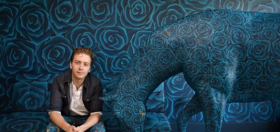
When the film The Danish Girl premiered Nov. 27, the real-life Lili El would have been delighted that we’re still discussing and portraying her 84 years after she died. She and her creative partner/spouse did all they could to create mystery about her life. Like many artists, Lili and Gerdahad had a flair for self-mythologizing, making it difficult to separate fact from fantasy in their remarkable stories.
Here’s what we know for sure, as well as some gentle debunking of what is probably artistic license by Lili, Gerda, and those who wrote about them.
1. Naming Transgender
This article refers to the couple by their chosen names Lili and Gerda, because each had several surnames over the course of their lives. Lili used a male name and pronouns for her first 30 years, but this article uses Lili and female pronouns throughout, in keeping with current professional guidelines for journalists covering trans people.
How about we take this to the next level?
Our newsletter is like a refreshing cocktail (or mocktail) of LGBTQ+ entertainment and pop culture, served up with a side of eye-candy.
2. Lili was not the “first”
The second complication is media obsession with “firsts.” Lili was not the first transgender woman. Transgender people have existed in every time and culture in recorded history. Lili was not the first to have surgical procedures that some trans people elect to have. Genital modifications including castration and penectomy are described in the Old Testament and have been practiced by India’s hijra for centuries. Lili was also not the first to be treated under the auspices of western medicine. She met several other patients when she traveled to Berlin for treatment at Magnus Hirschfeld’s Institut für Sexualwissenschaft, she said she didn’t like any of them. In fact, according to Man Into Woman, Lili’s autobiography edited by Niels Hoyer, “their movements, their voices, the way in which they were attired, produced a feeling of nausea.” She was certainly among the first to have ovarian implants and vaginoplasty, but it’s difficult to say she was the first, as contemporary records were destroyed when World War II swept across Europe.
3. Personal History
Lili was born December 28, 1882 in Vejle, Denmark, according to a 1902 Danish voter registration card listing her birth name. Lili trained in the arts at the local academy, then enrolled at the Royal Danish Academy of Fine Arts in Copenhagen. There, Lili met fellow art student Gerda Gottlieb. They got married in 1904, taking Lili’s original surname Wegener, and they traveled Europe for eight years before making Paris their home in 1912.

4. Model Behavior
Here’s where Lili’s origin story gets murky. According to Lili, Gerda was scheduled to have a female model sit for a work she was creating, but the model was unable to make the session. An actress friend named Anna Larsen suggested Gerda have her spouse sit for the session in the model’s costume. Lili balked at Gerda’s request, but after eventually relenting and getting dressed up, Lili began doing it on a regular basis. The name Lili was bestowed by their actress friend, and Lili and Gerda began appearing in public at some social events. Gerda explained that her companion was her spouse’s sister, but Lili was basically an open secret in the art world at that point. Lili continued to present as both male and female into the 1930s.
5. Creative Talents
Lili became Gerda’s muse and model, and Gerda’s work depicting a sultry feminine ideal captured the imagination of the time. Exactly one century ago, as World War I raged, both artists had established themselves as notable figures in the Paris art scene. Gerda became well-known as an illustrator, and a good one at that.
Lili was a popular landscape painter. Below is an example of her work, which often included two women enjoying the scenery or other female themes:
Lili stopped painting later in life, saying that it was part of her old life.
After the war, Gerda explored more themes of erotica and fashion. Below are some examples of her work, which did little to quell the speculation that she was a lesbian.
Gerda gained considerable renown in Paris between the World Wars, and she continued to have gallery showings in Copenhagen.
6. Science of trans
Meanwhile, since the dawn of the 20th century, researchers had been making significant strides in the scientific understanding of sexual differentiation and the various hormones produced by the endocrine system. Among the most noted researchers was Magnus Hirschfeld of Berlin, whose Institute for Sex Science had performed a number of medical procedures on transgender patients in the late 1920s and early 1930s. Another was Kurt Warnekros, a Dresden-based physician who examined Lili in Paris in 1930 and referred her for surgery with Hirschfeld in Berlin. In order for Lili to be admitted to Warnekros’ Women’s Clinic in Dresden, she had to be classified as a woman. The movie condensed a lot of this and made the clinics, doctors, and procedures an amalgam for simplicity’s sake.
In 1930, Lili traveled as a male to Berlin and met several other transgender patients, but she found them all nauseating. On the same trip Lili told a friend she never considered herself a gay man and had always been attracted to women. She completed an orchiectomy (removal of testicles) with Dr. Hirschfeld, which then qualified her to be admitted to the National Women’s Clinic in Dresden under the care of Dr. Warnekros. There she would have three more procedures over the next 16 months, including an ovarian transplant and a penectomy.
7. Death of A Remarkable Couple
Sensationalistic news reports of Lili’s procedures appeared in the press. In October 1930, Lili and Gerda traveled to Copenhagen and had the king annul their marriage. Lili got a new passport with her legal name Lili Ilse Elvenes. In summer of 1931, Lili returned to Dresden for what would be her fourth and final procedure, but she died on September 13, 1931. She was buried in a tomb marked Lili Elbe, named after the river that flows through the town where she had her final surgeries.
Gerda moved on, marrying an Italian military diplomat and moving to Morocco. They divorced in 1936, and she returned to Denmark, where she died in 1940. Magnus Hirschfeld’s Institute was looted by the Nazis in 1933, and the books and records burned. Hirschfeld died in exile in 1935. Kurt Warnekros’ Dresden clinic where Lili had surgery was destroyed by Allied bombs in 1945, and all records were lost. Warnekros died in 1949.
The art and the anecdotes of this remarkable couple are all that remains.
The most thoroughly-researched writing on the topic is Zagria in A Gender Variance Who’s Who, a collection of transgender biographies.






















